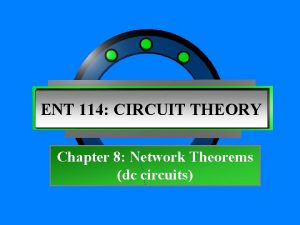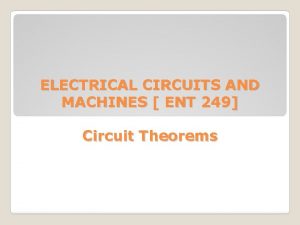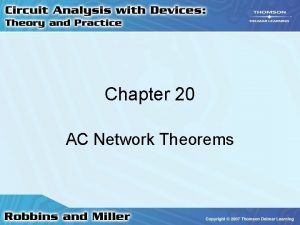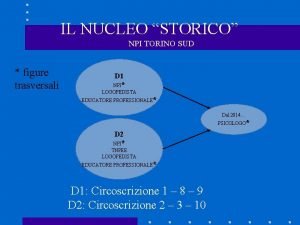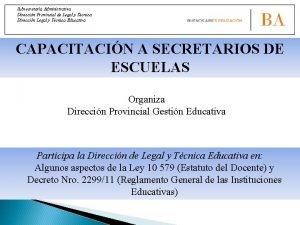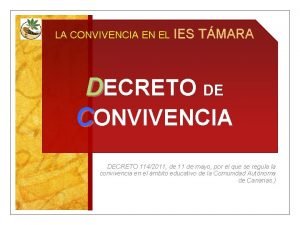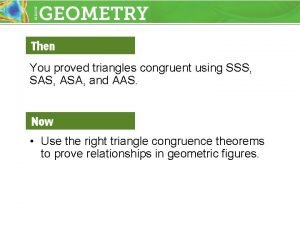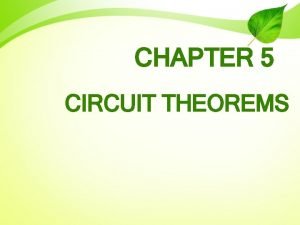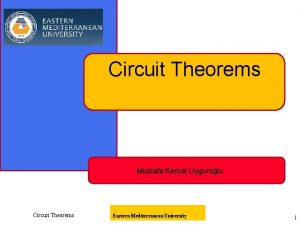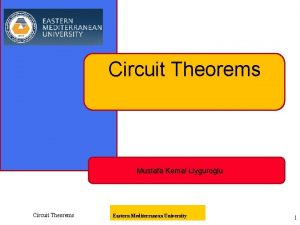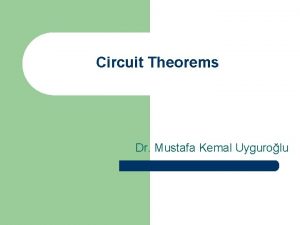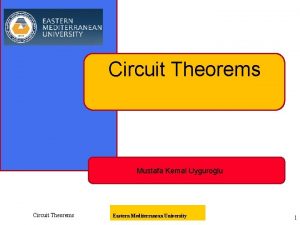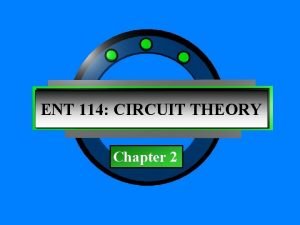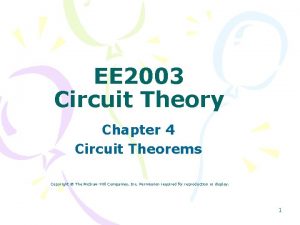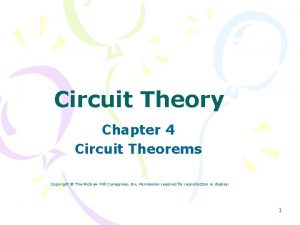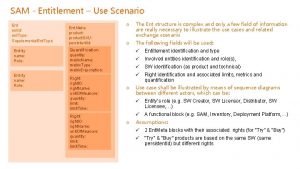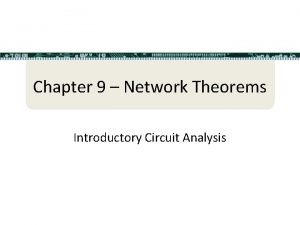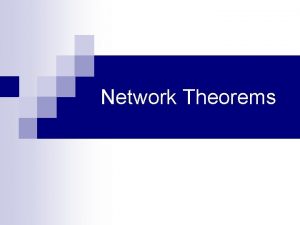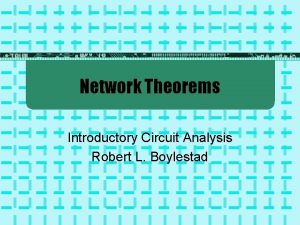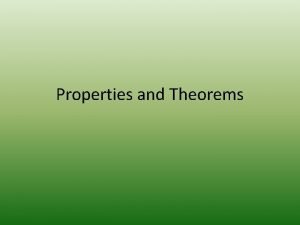ENT 114 CIRCUIT THEORY Chapter 8 Network Theorems






































- Slides: 38

ENT 114: CIRCUIT THEORY Chapter 8: Network Theorems (dc circuits)

Constant-current and Constant Voltage Source • In an electric circuit, a source of electrical energy could be represented by a source of e. m. f in series with a resistance. • This is not, however, the only form of representation • Consider a source load resister RL as shown in Figure 8. 1

Constant-current and Constant Voltage Source Is Where Is= E/Rs is the current which flow across output terminals of the source Figure 8. 1

Constant-current and Constant Voltage Source

Removing a voltage source and a current source to permit the application of the superposition theorem.

Superposition Theorem _The superposition theorem state that, The current in any given branch of a multiplesource linear circuit can be found by determining the currents in that particular branch produced by each source acting alone, with all the other source replaced by their internal resistance. The total current in the branch is the algebraic sum of the individual source currents in that branch.

Superposition Theorem • Applying Superposition Theorem 1. Take one voltage source at a time and replace each of the other voltage source with a short (a short represent zero resistance) 2. Determine the current or voltage just as if there was only one source in the circuit. 3. Take the next source in the circuit and repeat the previous two steps for each source. 4. To find actual current or voltage, add or substract the currents or voltages due to individual source. If the currents are in the same directions or the voltages are of the same polarity, add them and vice versa.

Example 9. 1 I 3 I 2

Example 9. 1 I 1 a I 3 a I 2 a The current I 2 b is negative because opposite direction • The network with the 20 V source replaced by a short-circuit.

Example 9. 1 • Next replace 10 V source with a short. I 1 b I 3 b I 2 b

Example 9. 2 • Determine the current in the 8 Ω resistor (R 1) in the circuit.

• The network with the 3 A source replaced by an open circuit. IR 1’ • Then, replaced 6 V source by a short circuit – Apply current devider rule to determine IR 1’’

Example 9. 3 • Determine the current in the 12 Ω resistor

Used current devider rule to determine I’ 2

Used current devider rule to determine I’’ 2

To determine current I 2 for the network: The net current therefore is the difference of the two and in the direction of the larger current:

Thevenin’s Theorem • Thevenin’s Theorem is a method for simplifying a circuit to a standard equivalent form.

Thevenin’s Theorem state that, An active network having two terminals A and B can be replaced by a constant-voltage source having an e. m. f E and internal resistance r. The value of E is equal to the opencircuit potential difference between A and B with the load disconnected and the source of e. m. f replaced by their internal resistance.

Thevenin’s Theorem Procedure Original Step 1 and 2 Step 1: Remove the load resistor RL. Step 2 : Mark the terminal as a and b. We have an open circuit across terminal a and b.

Thevenin’s Theorem Procedure • Step 3: – Replace the voltage source with a shortcircuit equivalent. – Calculate the RTH

• Step 4: – Put back the voltage source. Apply voltage devider rule to find VTH • Or using Mesh current analysis: Loop 1 Loop 2

Thevenin’s Theorem Procedure • Step 5: – Draw the Thevenin equivalent circuit. – Placed the RL. Across terminal a and b. • Addition: – If require to measure current IL,

Example 9. 4 • Determine the current in the 12 Ω resistor

Apply KVL to Loop A A Apply KVL to Loop B B

• Thevenin equivalent circuit • Current across 12 Ω resistor is:

Norton’s Theorem • The theorem states that, _Any two-terminal linear bilateral dc network can be replaced by an equivalent circuit consisting of a current and a parallel resistor.

Norton’s Theorem Procedure • Step 1: Remove the portion of the network across which the Norton equivalent circuit is found. • Step 2: Mark the terminal as a and b. We have an open circuit across terminal a and b.

Norton’s Theorem Procedure • Step 3: – Replace the voltage source with a shortcircuit equivalent. – Calculate the RN

Norton’s Theorem Procedure • Step 4: Indicate the short circuit connection between the terminal a and b.

Norton’s Theorem Procedure Step 5: Draw the norton equivalent circuit. Converting the Norton equivalent circuit to a Thevenin equivalent circuit.

Example 9. 5 • Determine the current in the 12 Ω resistor using Norton Theorem

Maximum Power Transfer Theorem _ The maximum power transfer theorem states the following: A load will receive maximum power from a network when its total resistive value is exactly equal to the Thévenin resistance of the network applied to the load. That is, RL = RTh

• For the Thevenin equivalent circuit like the figure below, when the load is equal to the Thevenin resistance, the load will receive maximum power from the network

• With RL= RTh, the maximum power delivered to the load can be determined by first finding the current:

PL versus RL for the network

Example 9. 6 • i. For the circuit below, determine The value of the load resistor, RL, which would give the maximum power transfer. ii. The maximum power transferred to the load

Example 9. 4 • Thevenin resistance is • Determine the Thevenin voltage

Example 9. 4 • Applying KVL
 Pseudocolor image processing
Pseudocolor image processing Devider
Devider Northon theorem
Northon theorem Dc circuit theorems
Dc circuit theorems Comparison between virtual circuit and datagram network
Comparison between virtual circuit and datagram network Packet switched network vs circuit switched
Packet switched network vs circuit switched Ac network theorems
Ac network theorems Ac network theorems
Ac network theorems Csit 114
Csit 114 Sas 114 letter sample
Sas 114 letter sample Eosc 111 ubc
Eosc 111 ubc Taskj-114
Taskj-114 Who wrote psalm 114
Who wrote psalm 114 Po odparowaniu wody z 32 5 g nasyconego roztworu
Po odparowaniu wody z 32 5 g nasyconego roztworu Crm 114 discriminator
Crm 114 discriminator Asl via alassio 36 torino
Asl via alassio 36 torino The fact act
The fact act Snake
Snake Aiaa s-114
Aiaa s-114 Oesd 114
Oesd 114 Via lucis 1 estacion
Via lucis 1 estacion Hbu 115
Hbu 115 Solicitud de licencia articulo 114 y 115 decreto 688/93
Solicitud de licencia articulo 114 y 115 decreto 688/93 Powstanie islamu
Powstanie islamu Decreto 114/2011
Decreto 114/2011 Series vs paralle
Series vs paralle Parallel circuit vs series circuit
Parallel circuit vs series circuit Circuit construction kit
Circuit construction kit In series vs in parallel
In series vs in parallel Incomplete circuit
Incomplete circuit Short circuit schematic diagram
Short circuit schematic diagram Venn diagram of heat and electricity
Venn diagram of heat and electricity Circulatory system labeled
Circulatory system labeled What is a parallel circuit in physics
What is a parallel circuit in physics Dynamic circuit network
Dynamic circuit network Dynamic circuit network
Dynamic circuit network Circuit switched network adalah
Circuit switched network adalah Triangle congruence theorems
Triangle congruence theorems Law of sines and cosines maze
Law of sines and cosines maze

